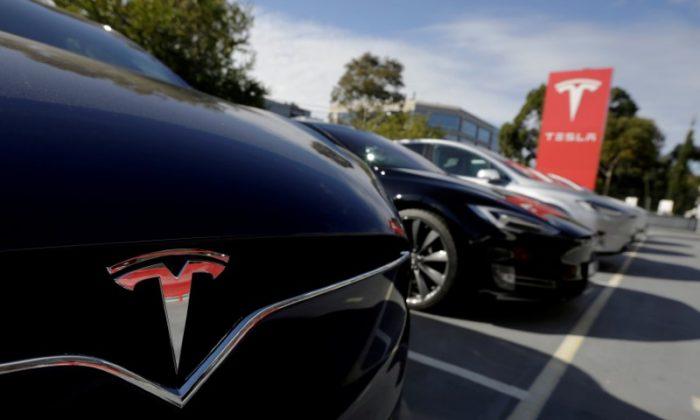Crossing the street in an age of electric vehicles has added risk.
The new transport technology is clean, powerful and quiet – so quiet pedestrians may not hear it at low speeds.
And that is what concerns Blind Citizens Australia president Fiona Woods, who says the near-silent vehicles will put all pedestrians at risk but leave some groups particularly vulnerable.
“I want people to know it’s a matter of life or death to people who are blind or vision-impaired,” Woods said.
The solution to this road safety risk, Woods and researchers assert, is technology installed in electric and hybrid vehicles that makes sounds at low speed when their engines do not.
Acoustic Vehicle Alerting Systems have been approved by the United Nations and made mandatory in Europe, Japan, China and the United States.
U.S. lawmakers are even weighing up whether to retrofit nine million older quiet vehicles with the sound-making technology.
But Australia has yet to follow international examples, leaving the technology’s inclusion up to manufacturers in a move academics and industry experts warn could lead to more road accidents.
The issue of “quiet road transport vehicles” was recently raised in the federal government’s National Electric Vehicle Strategy consultation.
Woods said Blind Citizens Australia called for urgent action in its submission because the issue directly impacted more than 500,000 people with blindness or low vision.
“It’s really important we have these alerting systems because we’re not opposed to electric vehicles – we want the planet to survive – but we want people to be aware of the pedestrian issues,” Woods said.
Woods said people with vision impairments listened to the noises cars made to determine everything, from the number of lanes on a road to whether it was safe to cross a street or even when their taxi or ride-share vehicle had arrived.
Vehicles with near-silent engines no longer gave them those clues, Woods said, making it hard for some people to navigate on their own.
“You need to be confident you’ve got the skills and that society supports your ability to get out,” Woods said.
“If you’ve had a near-miss with an electric vehicle or you know people who have had a near-miss you might start to think, ‘am I safe crossing that road?’ It affects people’s confidence.”
Research from Monash University’s Accident Research Centre, released in 2019, showed the issue could have widespread consequences.
More than one in three blind or vision-impaired pedestrians reported having a collision or near-miss with an electric or hybrid vehicle and almost one in four reported lower confidence as a result of quiet vehicles on roads.
Report author and associate professor Michael Fitzharris told AAP the issue was likely to worsen as the number of electric and hybrid vehicles grew unless policymakers acted swiftly to mandate acoustic alerts.
“Australia can be really forward-thinking by introducing this regulation now while there are not many electric vehicles on the road,” Fitzharris said.
“It would be proactively regulating and protecting the population from what we see will be a significant safety risk in the future.”
The European Union, China and United States launched laws to mandate the use of acoustic vehicle alert systems in 2019, while Japan introduced guidelines in 2010.
The regulations demand all electric and hybrid vehicles play sounds between 56 and 75 decibels – louder than a conversation but quieter than a petrol car – when travelling at speeds up to 20 km/h in Europe or 30 km/h in the U.S. Drivers cannot turn off the feature.
Automakers including Tesla, Hyundai and Nissan have introduced cars with acoustic alerts to Australia but others, Fitzharris said, remove the technology before sale.
“Some manufacturers have it but when they sell the cars in Australia they don’t fit it, which is crazy,” Fitzharris said.
“They de-specify safety features and in the absence of regulation that’s what can happen.”
By contrast, the issue is being taken so seriously in the United States, road safety regulators are considering a petition to retrofit quiet cars released since 1997 with the sound-making technology.
The National Highway Transportation Safety Administration will judge whether not having the alert system breaks America’s pedestrian safety laws, forcing a recall of 9.1 million vehicles.
In Australia, the issue has not only been raised for the National Electric Vehicle Strategy but Fitzharris said he was pleased to see acoustic vehicle systems listed as a priority in the National Road Safety Action Plan this month.
The feature is one of several to be reviewed by mid-2023 for inclusion in the Australian Design Rules, or national standards for vehicle safety.
Electric Vehicle Council policy head Jake Whitehead said introducing acoustic alerts in Australia would be smart as long as the rules did not unnecessarily create more barriers to getting zero-emission cars into the country.
“There’s already a United Nations regulation on quiet vehicles and what there acoustics should be,” Whitehead said.
“We would welcome Australia not creating a unique standard but aligning with the international standard that already exists.”
Adding extra sound to electric vehicles did not have to be a boring venture either, Whitehead said, and could bring futuristic whooshes or novelty noises to the streets.
“The great benefit in this is that although the vehicles are quieter, we have the ability to choose what we want that sound to be,” Whitehead said.
“Many Teslas have farting sounds as options but I’m not sure we want to go down that pathway. Within reason, we can customise those sounds to people’s preferences and meet a set of requirements that will help address those legitimate concerns from the vision-impaired community.”





